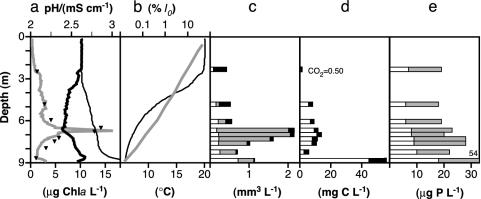Fig. 3.
Vertical distribution of plankton taxa, physical parameters, and nutrients in Lake 111 (September 15, 1999). (a) Chlorophyll a (Chla, triangles) and in situ fluorescence (gray line), pH (thin line), and conductivity (κ25, thick line). Conductivity indicates the presence of a mixed epilimnion (0–3 m), an intermediate layer (down to 6.5 m), and a deeper water layer. (b) Temperature (black) and PAR (gray, I0–surface irradiation). (c) Biovolume of nonfilamentous bacteria (white), phototrophs (Chlamydomonas, gray), and mixotrophs (Ochromonas, black). Median biovolumes of nonfilamentous (edible) bacteria from several sampling occasions were lower in epilimnion than in layers down to the DCM (3.6–7.6 m depth) (11 vs. 17 samples, P = 0.0005, two-tailed U test). Phototrophs were also higher in the depth (P = 0.0024). Mixotrophs exhibited higher biovolumes in epilimnion (P = 0.0147). Phagotrophs (heliozoans plus ciliates) and filamentous bacteria (less edible) did not vary in the vertical range (not shown, P = 0.2561 and 0.0509, respectively). Phagotroph biovolumes were 1.6 orders of magnitude lower than those of mixotrophs. Nonprotozoan phagotrophs were of low importance (22). (d) CO2 (white) and dissolved organic carbon (black). (e) Total phosphorus (whole column) and soluble reactive phosphorus (white). Nitrogen was found in excess (≥3,000 μg liter–1
 ). We did not detect H2S.
). We did not detect H2S.

